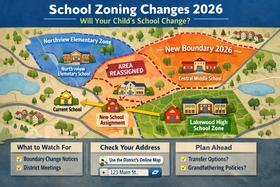Public education is a core element to an educated society and a successful democracy. The evolution of public schools in the United States began early in the 17th century, with the first settlers on American soil. Today, the public school system in the U.S. is a complex one with a multi-tiered form of governance and a multitude of programs to address the varying needs of students and their families. Understanding the definition, purpose and operation of public schools in the U.S. helps one get a broad picture of what public education in this country looks like.
Definition of Public Education
Wikipedia defines public schools as primary or secondary schools that are available to everyone within a country’s population. The schools are regulated and funded through government authority, and attendance is mandated by that government authority. Funding typically comes from taxation of the country’s citizens, and the money is generally allocated through the government entity designated to oversee the public school system.
This video offers a brief explanation of the American public school system.
In the United States, there is a three-tiered form of governance that oversees public education, which includes federal, state and local levels. At the federal level, the Department of Education, currently overseen by Education Secretary Arne Duncan, is the entity that established policies and laws involving education in the U.S. State education agencies also play a role in governing the public schools in their states, while individual school districts, run by elected school boards in most cases, offer their own form of oversight as well.
Facts and Figures
According to How Stuff Works, there are approximately 15,000 school districts currently operating in the United States. Because the majority of public school governance is handled at the local level, school districts can vary widely in terms of the curricula they use and the policies they follow. In most districts, students are assigned to a school based on location, with districts zoned to determine student populations for each school based on neighborhoods and addresses.
However, as school choice evolves throughout the U.S., alternative schools like charter and magnet schools are allowing parents to send their children to schools outside their immediate neighborhood. Open enrollment policies in many school districts also allow parents to choose the best public school for their children’s specific learning needs.
How Stuff Works states that during the 2007-2008 school year, approximately 49.6 million students were taught by around 3.2 million teachers in primary and secondary schools nationwide. School funding for that school year averaged just over $9,600 per student, with wide variations in that number between states and school districts. Because much of the revenue for public schools comes from property taxes, the location of the school determines how much money schools receive. Additional funding comes through state and federal resources.
Purpose of Public Education
The purpose of public education is one that is highly debated in education circles today. Originally, public schools were created as a part of the democracy experiment, of which the United States is still the greatest example today. In order to ensure that all members of the democracy were able to contribute to the system, education must be a part of the equation. The Core Knowledge website explains that citizens must have the “knowledge and skills” necessary to become active, productive members of the democratic society. This means that every member of the society must have access to the same quality of education – and a public school system is born.
This video explains how the American public education system works.
Access to a free education must be available to everyone. The U.S. Department of Education website includes qualified persons with disabilities in this mix. In fact, federal law requires that students with both physical and mental impairments receive an appropriate education, according to their specific needs. The same can be said for students of all races, gender, and income level. No student should be restricted from getting a public education that can help them become a successful and productive adult in the future.
How Today’s Public Schools Operate
PBS states that public schools today operate under larger education systems, which are comprised of the three-tier form of governance explained previously. Teachers in the education system are now highly trained individuals with college degrees and practical experience. The pool of public school teachers has become much more diverse, as the world of education has diversified overall.
Students in public schools today are separated according to grade, and in some cases, according to ability level. Schools are typically divided into three distinct types: elementary schools that handle grades K-6, middle schools or junior high schools with grades 7 and 8, and high schools that include grades 9-12. However, this structure can vary slightly from district to district. Some will have middle schools that include grades 6 through 8, while others have junior highs that handle 7-9. Charter schools are introducing a new school structure that includes grades K-8, with middle school students in a separate area of the building from primary students.
This video explains the American public school system.
Public schools today face numerous challenges in their daily operations, from crime in school to decisions on school choice and standardized testing. While educators may not agree on the various elements that go into creating successful public schools, they all share a common belief in the importance of a robust public education system. As the needs of students, communities and the workforce continue to evolve, we can rest assured changes to our public school system will continue to reflect those evolutions, as educators strive to meet the needs of the upcoming generations.
Questions? Contact us on Facebook. @publicschoolreview












